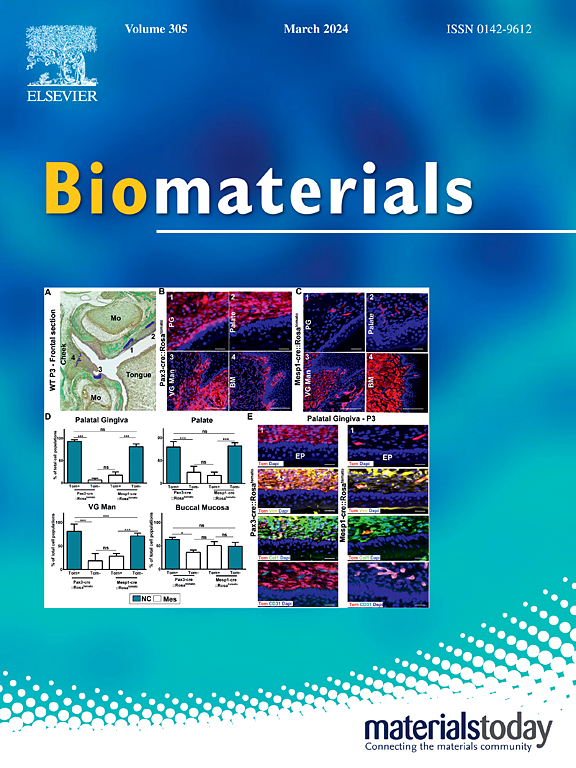原位喷洒血小板衍生的小细胞外囊泡,通过减少 PAN 凋亡促进皮瓣存活。
IF 12.8
1区 医学
Q1 ENGINEERING, BIOMEDICAL
引用次数: 0
摘要
随机皮瓣远端坏死仍然是一个重大挑战,限制了这些皮瓣在整形和重建手术中的临床应用。抑制缺血/再灌注(I/R)损伤和促进新血管网络的形成是重要的预防策略。血小板来源的小细胞外囊泡(PL-sEV)是生长因子的纳米载体,提供了临床使用的富血小板血浆和血小板裂解物的替代方案,具有更高的生长因子浓度和较低的免疫原性。在这项研究中,PANoptosis是一种不同形式的炎症细胞死亡,在随机皮瓣模型中得到了充分的表征。皮下注射PL-sEV通过增强血流灌注和降低PANoptosis水平改善缺血皮瓣存活。在体外,PL-sEV抑制氧葡萄糖剥夺/再氧诱导的人脐静脉内皮细胞功能障碍。此外,PL-sEV被整合到热敏三嵌段水凝胶中,形成可喷涂的输送系统(PLEL@PL-sEV)。通过RNA测序的机制分析表明,PL-sEV对PANoptosis的保护作用可能与其抗炎特性有关,特别是通过抑制NF-κB信号通路。这种新型的水凝胶系统显示了PL-sEV的可控释放,并证明了改善皮瓣移植结果的有效性。本文章由计算机程序翻译,如有差异,请以英文原文为准。
In-situ Sprayed platelet-derived small extracellular vesicles for the skin flap survival by reducing PANoptosis
Necrosis at the distal end of random skin flaps remains a significant challenge, limiting the clinical application of these flaps in plastic and reconstructive surgery. Inhibiting ischemia/reperfusion (I/R) injury and promoting the formation of neovascular networks are critical preventive strategies. Platelet-derived small extracellular vesicles (PL-sEV) are nanocarriers of growth factors that provide an alternative to clinically used platelet-rich plasma and platelet lysates, offering higher growth factor concentrations and lower immunogenicity. In this study, PANoptosis, a distinct form of inflammatory cell death, was fully characterized in a random skin flap model. Subcutaneous injection of PL-sEV improved ischemic skin flap survival by enhancing blood perfusion and reducing PANoptosis levels. In vitro, PL-sEV inhibited oxygen–glucose deprivation/reoxygenation-induced dysfunction in human umbilical vein endothelial cells. Furthermore, PL-sEV was incorporated into a thermosensitive triblock hydrogel, creating a sprayable delivery system (PLEL@PL-sEV). Mechanistic analysis through RNA sequencing indicated that the protective effects of PL-sEV against PANoptosis likely resulted from its anti-inflammatory properties, particularly via suppression of the NF-κB signaling pathway. This novel hydrogel system demonstrated controlled release of PL-sEV and proved effective in improving skin flap transplantation outcomes.
求助全文
通过发布文献求助,成功后即可免费获取论文全文。
去求助
来源期刊

Biomaterials
工程技术-材料科学:生物材料
CiteScore
26.00
自引率
2.90%
发文量
565
审稿时长
46 days
期刊介绍:
Biomaterials is an international journal covering the science and clinical application of biomaterials. A biomaterial is now defined as a substance that has been engineered to take a form which, alone or as part of a complex system, is used to direct, by control of interactions with components of living systems, the course of any therapeutic or diagnostic procedure. It is the aim of the journal to provide a peer-reviewed forum for the publication of original papers and authoritative review and opinion papers dealing with the most important issues facing the use of biomaterials in clinical practice. The scope of the journal covers the wide range of physical, biological and chemical sciences that underpin the design of biomaterials and the clinical disciplines in which they are used. These sciences include polymer synthesis and characterization, drug and gene vector design, the biology of the host response, immunology and toxicology and self assembly at the nanoscale. Clinical applications include the therapies of medical technology and regenerative medicine in all clinical disciplines, and diagnostic systems that reply on innovative contrast and sensing agents. The journal is relevant to areas such as cancer diagnosis and therapy, implantable devices, drug delivery systems, gene vectors, bionanotechnology and tissue engineering.
 求助内容:
求助内容: 应助结果提醒方式:
应助结果提醒方式:


